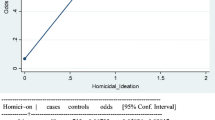Abstract
This study concerns client success or failure while residing in a halfway house for adult offenders. As with some other studies, failure or recidivism is defined in this analysis as behavior that results in removal from the facility and subsequent incarceration. This quantitative case study of one treatment facility in Tennessee utilized case records on the population of clients from 1981 through 1987 (N = 75). A number of hypotheses were developed and tested with both bh/ariate and multivariate methods. Results indicated that, at least in this halfway house, those residents who had experienced two or more prison terms and who had most recently been convicted for a violent crime were most likely to recidivate while in the facility. Other substantively significant factors were alcohol use, religious attendance, and the experience of mental health counseling. Programmatic implications of these results are discussed.
Similar content being viewed by others
References
Allen, H. E., E. W. Carlson, E. C. Parks, and R. P. Seiter (1978) Halfway houses. Washington, DC: Department of Justice, Law Enforcement Assistance Administration.
Beck, J. L. (1981) Employment, community treatment centre placement, and recidivism: A study of released federal offenders. Federal Probation.45, 3–8.
Beha, J. A. (1976) Testing the functions and effect of the parole halfway house: One case study. Journal of Criminal Law and Criminology.67, 335–350.
Bonta, J. and L. L. Motiuk (1985) Utilization of an interview-based classification instrument: A study of correctional halfway houses. Criminal Justice and Behavior.12, 333–352.
Bonta, J. and L. L. Motiuk (1987) The diversion of incarcerated offenders to correctional halfway houses. Journal of Research in Crime and Delinquency.24, 302–323.
Conrad, J. (1965) Crime and corrections. Berkeley, CA: University of California Press.
Donnelly, P. G. and B. Forschner (1984) Client success or failure in a halfway house. Federal Probation.48, 38–44.
Gendreau, P. and R. R. Ross (1987) Revivification of rehabilitation: Evidence from the 1980s. Justice Quarterly.4, 349–407.
Gibbons, D. C. (1977) Criminal justice planning. Englewood Cliffs, NJ: Prentice Hall.
Greenfeld, L. A. (1985) Examining recidivism. Washington, DC: Bureau of Justice Statistics.
Harrell, F. E. (198C)The LOGIST procedure [Computer program manual]. Cary, NC: SAS Institute. (SAS user’s guide international, pp. 269–292).
Harreil, F. E. and K. L. Lee (1985) A comparison of the discrimin ation of discriminant analysis and logistic regression under multivariate normality. In P. K. Sen (Ed.). Biostatistics: Statistics in biomedical, public health and environmental sciences (pp. 333–343). New York: North Holland for Elsevier Publications.
Innes, C. A. (1988) Profile of state prison inmates. 1986. Washington, DC: Bureau of Justice Statistics.
Latessa, E. and H. E. Allen (1982) Halfway houses and parole: A national assessment. Journal of Criminal Justice.10, 153–163.
Moczydlowski, K. (1980) Predictors of success in a correctional halfway house for youthful and adult offenders. Corrective and Social Psychiatry and Journal of Behavior Technology. Methods and Therapy.26, 59–72.
Moran, E. L., W. A. Kass, and D. C. Munz (1977) In-program evaluation of a community correctional agency for high-risk offenders. Corrective and Social Psychiatry and Journal of Behavior Technology. Methods and Therapy.23, 48–52.
Press, S. J. and S. Wilson (1978) Choosing between logistic regression and discriminant analysis. Journal of the American Statistical Association.73. 699–705.
Seiter, R. P., E. E. Carlson, H. Bowman, J. Grandfield and N. Beran, (1977). Halfway houses: National evaluation program: Phase I. summary report. Washington, DC: U. S. Department of Justice.
Smykla, J. (1981) Community based corrections. New York: MacMillan Publishing.
Thalheimer, D. J. (1975) Cost analysis of correctional standards: Halfway houses. Washington, DC: American Bar Association.
Wallerstedt, J. (1984) Returning to prison. Washington, DC: Bureau of Justice Statistics.
Wilson, J. Q. (1977) Thinking about crime. New York: Vintage Books.
Author information
Authors and Affiliations
Rights and permissions
About this article
Cite this article
Walsh, C.L., Beck, S.H. Predictors of recidivism among halfway house residents. AJCJ 15, 137–156 (1990). https://doi.org/10.1007/BF02887461
Issue Date:
DOI: https://doi.org/10.1007/BF02887461




